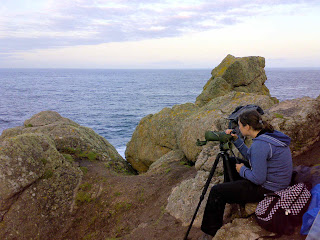
One other observer was an integral part of the team for the five days I spent on Gwennap Head. Julie Hitchins, coincidentally also down from Redditch, was tallying cetaceans, sharks and seals. The project’s remit covered much more than Balearic shearwaters.
Together, we counted nothing the first hour as we struggled to construct a shelter from a couple of umbrellas and a few tent ropes. We’d both seen the finished result the day before but had failed to register the exact configuration.
We did finally settle down to surveying but didn't fare much better until John arrived. There's a technique to this lark. I've already touched on having the right equipment but using it correctly is just as important. For a start it helps to know the general route that the target birds will take.
In our case we knew that the Balearics would more or less accompany Manx shearwaters, which we were also counting. They were flying on an east-to-west line about a kilometre out. In theory, scanning this route in the opposite direction should have caught most of the birds. In practice, the sea was pretty same-y and offered little guidance to keeping a telescope on this line.
The answer was not to scan at all but to park the scope on a hotspot. Conveniently, the Runnelstone buoy sat about a mile offshore. Keeping this in the top of the view kept the line of flight in the bottom. Not quite as interesting or active as continually scanning, but more reliable. The best seawatching spots in the country have these offshore markers. They also serve to guide other observers on to a sighting and to find what someone else is excitedly shouting about, provided you leave your scope parked even when not attending to it.
After a while you can determine some structure to the local patch of sea, thanks to prevailing winds and underlying topography, like reefs. Then you can scan out a bit but it’s no good randomly swinging a telescope round the entire ocean right from the start.
In the course of this experimentation I also discovered a feature, unsuspected for six years of telescope ownership. I had always had great trouble looking through other people’s; the image seemed to waver and sometimes disappear completely. I chose my Kowa because it did less of this but it still wasn't perfect. It has a rubber rim that surrounds the eye end of the eyepiece. I must have absently rolled it back.
Blimey! Suddenly the image was solid and with a much greater field of view. The rubber was only the thickness of a pound coin but it had been sufficient to push my eye too far away. I do have very deep set eyes. Think Tom Cruise but without the rest of the looks (or the money. Or Nicole Kidman. Oh no, neither has he now!)
Anyway opticals designed for the normal face don't cut it for mine. Inspired by this discovery, I tried looking through my binoculars without my glasses on. Same result. Instant increase in steadiness and clarity. Now if I could just train my eyes not to need spectacles... ⇐ ⇒





No comments:
Post a Comment